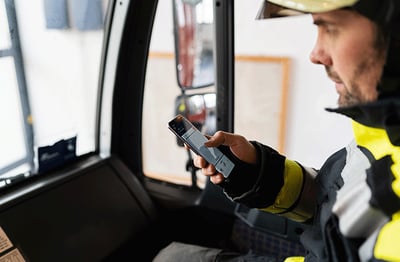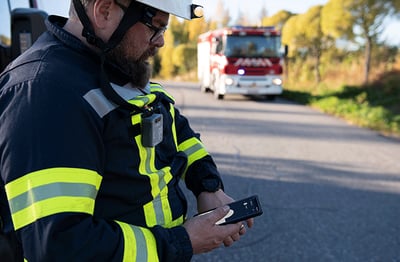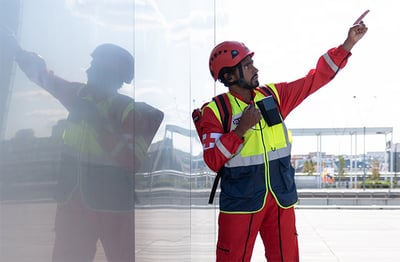Let’s say your organization has decided to adopt broadband and apps for professional use. How are RFID, NFC and IoT related to that? Do you need to consider these technologies? If yes, then how? This blog post gives you an overview.
This is the fourth in a series of blog posts on how to bring smartphones, hybrid devices and apps into professional use. Today, we discuss RFID, NFC and IoT – three abbreviations and terms that have one thing in common: they are all related to the exchange of information between computers, devices or things - without human interaction.
RFID and NFC are based on the same technologies, and IoT is based on other core technologies.
RFID - Radio Frequency Identification – is a wireless (contactless) communication technology for communication between a tag and a reader. RFID is most often used with passive tags over a few meters’ range. The following questions will get answered:- What does RFID stand for?
- How does RFID work?
- Where is RFID used?
- What does NFC stand for?
- How does NFC work?
- Where is NFC used?
- What does IoT mean?
- How does IoT work?
- Where is IoT data stored?
- Why is IoT important to think about right now?
- How is IoT changing the world?
- What can IoT do?
- IoT - who owns the data?
- Are IoT devices secure?
- How should I consider RFID, NFC, and IoT?
Let’s start with the first abbreviation – RFID.
What does RFID stand for?
RFID is an abbreviation of Radio Frequency Identification. It is a wireless (contactless) communication technology and enables the communication between a tag and a reader.
RFID uses electromagnetic fields to automatically identify and track tags attached to objects. The tags contain electronically stored information. Unlike a barcode, the tag does not need to be within the line of sight of the reader, so it may be embedded in the tracked object.
Passive tags collect energy from a nearby RFID reader's interrogating radio waves and their range is usually a few meters. Active tags have a local power source (such as a battery) and may operate hundreds of meters from the RFID reader.
How does RFID work?
At a simple level, RFID systems consist of three components:
- an RFID tag or smart label
- an RFID reader
- an antenna.
RFID tags contain an integrated circuit and antenna which transmit data to the RFID reader (also called an interrogator). The reader then converts the radio waves to a more usable form of data. Information collected from the tags is then transferred through a communications interface to a host computer system, where the data can be stored in a database and analyzed at a later time.
Where is RFID used?
The most common use of RFID tags is in identification badges used for access control. The badge only needs to be held close to the reader to authenticate the holder (and open the door, for example).
Many libraries use RFID tags today on the books and other items on loan. When a tagged item is checked out, the system updates the inventory accordingly.
A similar system could be used for the cataloguing and inventory of items inside an ambulance. Whenever a tagged item is used, the system recognizes this and updates the inventory. Real-time inventory is available whenever the ambulance is re-stocked.
Police officers are required to carry certain items and devices while on duty.
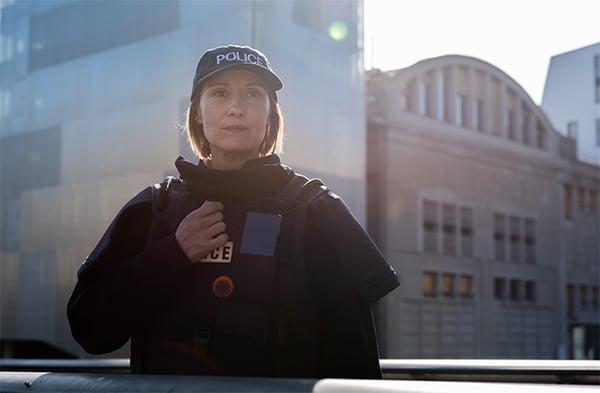
A smartphone app could give a packing list for the police, and check the RFID tagged items as the officer packs them. The app could give an alert if the officer was about to leave the storage without an item on the list – for example, without a pair of protective gloves.
Then we move to the next abbreviation on the list: NFC.
What does NFC stand for?
NFC means near-field communication, and very simply put, it is technology that enables two electronic devices to communicate over the air when they are very close (within 4 cm of each other). NFC is also one of the RFID protocols.
How does NFC work?
NFC uses electromagnetic induction between two antennas when the two devices exchange information, operating on a globally available unlicensed radio frequency band (13,56 MHz).
The two devices usually have a power source each, and this makes it possible for them to exchange data in both directions.
Where is NFC used?
A typical example of NFC in action is the contactless payment. NFC is also used when sharing contacts or photos from one smartphone to another, or when pairing headsets, media players or other gadgets with a smartphone.
Then, we arrive to perhaps the most intriguing of the abbreviations: IoT.
What does IoT mean?
IoT is the abbreviation of the term the Internet of Things. It is a general term, meaning that all devices and vehicles and other objects in our home and professional lives are connected via the internet. This connection can be automatic, requiring no action from any human being.
Technically, IoT is based on a specific machine-to-machine communications method defined in the 3GPP (3rd Generation Partnership Project).
IoT can be used to connect sensors to the Internet and collect a continuous flow of data from them. The collected data can be processed into information, insights and predictions. People can then use these as basis for intelligent decisions.
The plans for 5G mobile technology include the IoT and in fact, the need for IoT is a huge driver for all 5G related development.
How does IoT work?
The data collected by the connected devices and sensors has to be processed – otherwise it is just data which as such would not provide any insights to a human being.
For processing, the data is sent to a cloud to be analysed, as it needs a way to get there. This data may be very simple, such as a temperature reading, and it may also be complex, such as a video stream.
The devices and sensors send the data to the cloud via gateways. The gateways can use mobile networks and satellite connections to transmit the data.
IoT devices have a typical range of several kilometers.
When the data is in the cloud, the IoT platform will process it. Simple data such as a temperature is simple to process: for example, the IoT platform may check if the temperature is within a certain range. Complex data such as video requires more from the processing: computer vision to identify objects, for example.
Next, the processed data is delivered in a human-consumable format to users. This information may be in the form of alerts, emails, or text messages. The user may also have an application to actively browse the information.
Data analytics in the IoT platform can use historical data as basis for actionable insights such as what might happen or how the situation might develop in the future. Data analytics might pinpoint early indications of an upcoming malfunction in equipment and estimate its likelihood in a certain time frame.
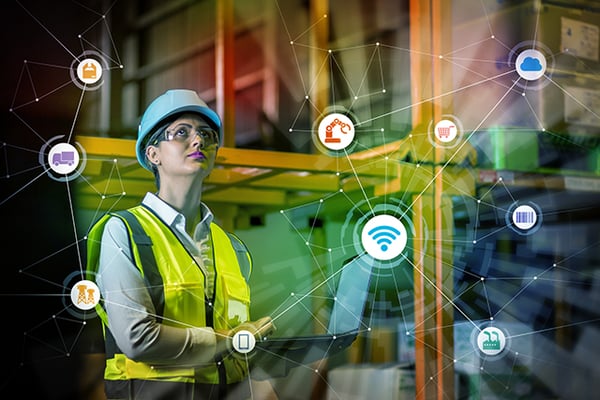
Where is IoT data stored?
This is a question you will need to consider if you are planning to introduce apps that use IoT data.
IoT data is not very useful if it isn’t analysed and transformed into actionable information. It is obvious that simple sensors cannot do this – the data needs to be transferred from them and stored, at least for the time it takes to analyse it.
Simply put, there are three choices for storing data:
- on-premises storage
- private cloud
- public cloud.
Your best choice depends on how much budget and resources you have and on how critical and confidential your data is.
Your organization may already be using on-premises technologies and systems to store data. That may be your preferred choice for IoT data in the future as well. But if your data rooms start getting bigger and bigger, or if your organization recognizes a need for more streamlined sharing of data, you may need to look at cloud storage.
Why is IoT important to think about right now?
The size of sensors has decreased while their processing power has increased. At the same time, their prices have decreased. The prices are starting to be low enough to allow wearable sensors, for example, to become a mass market.
What’s more, standards have matured.
Finally, cloud technology has become widely available, making it simpler to set up end-to-end solutions for IoT.
How is IoT changing the world?
Cloud technology, big data, ubiquitous connectivity and the amalgamation of analytics have introduced huge potential to controlling and managing devices, remote monitoring, and building insights from the vast amounts of data.
In the near future, IoT devices will be practically everywhere. Smart energy saving systems have already become common. Many people wear activity bracelets, and advanced devices would help them track their health in more detail.
Changing cities
IoT is predicted to change cities dramatically: Connected cars linked with smart city and traffic solutions will transform routes and transportation in general. IoT systems could reduce traffic congestion, enhance public transportation systems, and create more efficient and cost effective municipal services.
People safety
IoT may also have a huge role in keeping people safe. Combining data from privately owned sensor data with that from public or governmental sources can open up interesting possibilities. For example, a police department might introduce (and in some places, have already introduced) a voluntary registration system for private security cameras. The police would be allowed to use the feed from the registered cameras and would have the possibility to check the privately captured footage to support their crime investigations.
What can IoT do?
IoT allows one to collect data from inanimate objects: sensor data, images, videos. IoT systems can analyse current and historical data and share the resulting insights. Public safety and other professional organizations have the opportunity to use significantly more data and information as basis for critical decision-making. This is the added value to professional users that IoT provides.
For public safety professionals -
IoT can improve a firefighter’s or a police officer’s personal safety:
- The wearable sensors collect data on the person’s vital signs and of the environment.
- A mobile device can be used as a sensor hub, collecting this data and transmitting it to the cloud for data analysis.
- The IoT platform will then provide insights to the command centre, where the people in charge will get improved situational awareness.
A firefighter’s sensors may track his oxygen level and heart rate as his vital signs, the air tank levels, and toxic gas sensors may track his surroundings. The sensor hub will receive the sensor data and can combine this with video from the firefighter’s wearable camera and thermal camera and with his 3D acceleration sensor.
The sensor hub can then send the combined data to the IoT platform in the cloud for analysis and predictions. The platform will visualize its insights for the command centre. People at the centre can make better informed decisions and give instructions or commands to the firefighter as necessary.
A police officer would benefit from similar vital signs monitoring and IoT insights. In addition, the police officer’s location could be monitored and the IoT platform could combine this data with historical data about the risk levels associated with the location.
One wearable sensor could recognize gun shots fired nearby, and another one could trigger an alert when the officer’s gun is drawn from the holster. These, in turn, could be triggers to activate the officer’s video camera and start sending the feed to the control centre.
In other words, wearable IoT sensors and the insights provided by data analytics can predict when the impending man down is likely to happen.
No matter how advanced a man-down solution might be, it is much better for the command centre to know the risk beforehand and take preventive measures than deal with a man-down situation.
For public safety in general -
A simpler, yet very effective IoT solution would be a ”smart siren,” a population alerting system that would sense its surroundings. A sensor would be used to monitor radiation levels or the presence of toxic gases in the air and trigger the siren when a threshold level was reached.
Looking at the bigger picture, predictions based on reliable data analytics help professionals prevent, mitigate and quickly react to any incident regardless of its magnitude.
Handpicked related content
Watch webinar "IoT and AI - never before seen opportunities for public safety". It reveals a number of practical use cases for the Internet of Things IoT and Artificial Intelligence AI. You will also learn why public safety organizations should be interested in IoT and AI now.
IoT - who owns the data?
Wearable sensors and IoT devices will be widely adopted and for professional organizations, control of data is critical. You need to think about the ownership of the data collected by your sensors and devices.
When your operations are based on a command hierarchy, you should also be able to tie the sensors you use to the same hierarchy. Otherwise, how could you control who or which data analytics use the data from your sensors, or who can access the insights from that data?
Are IoT devices secure?
When done correctly, IoT can be reliable and secure, but there are also risks involved, in particular for mission-critical users.
The risks of IoT are related to security and privacy – how to keep safe all this data from companies’ sensors, from public safety professionals’ wearable sensors, from people’s homes, about their movements and their actions, and how to make sure that the data is only used in an appropriate way.
There is also a risk that a malicious party could feed fake data into the system, or block some sensors entirely. Obviously, decisions based on fake or incomplete data would be questionable. This risk can be mitigated by using data collected from as many sources as possible and combine the data with analytics to maximize the odds that the data is legitimate.
Other risks include society’s dependence on networks and how power black-outs are handled when most things in buildings and cities are dependent on electricity and communication networks.
How should I consider RFID, NFC, and IoT?
Why should your organization consider RFID, NFC or IoT related topics before introducing hybrid devices or advanced applications?
One important reason to consider the relationship between RFID or NFC based solutions and hybrid devices or applications is control.
For example, the risk of reading information from RFID tags without consent or proper authorization is addressed on a technical level with cryptography and authentication methods, but in addition, a system for managing the authorizations is needed.
How will your organization control which users or devices can use which RFID/NFC based solutions? Which tags will a user’s device be allowed to read? Which NFC has access to which user device? And how will you put in place a hierarchy of access rights?
For IoT, it is also important for you to recognize that wearable sensors and IoT devices will soon become widely available. Look for hybrid devices and applications that do not lock your choices. Make sure your data stays in your ownership.
And like with RFID/NFC based solutions, control is important.
When your operations are based on a command hierarchy, you should also be able to tie the sensors you use to the same hierarchy. Otherwise, how could you control who or which data analytics use the data from your sensors, or who can access the insights from that data?
You should also consider how to achieve the necessary levels of reliability for your end-to-end solutions based on these technologies. One way to achieve system reliability is to have a duplicated system. One technology could serve as the primary platform, and if that became unavailable, another backup system, operating on a different technology would step in. In a hybrid environment, a digital radio network could be the backup for a broadband LTE/4G/5G network.
Your next smart step
If your organization uses or is considering to use smartphones, hybrid devices or apps in operation, you will want to become a hybrid insider!
Get more info on the exciting possibilities in the new, hybrid world – delivered directly into your email Inbox. You will get updates on hybrid devices and hybrid apps, and you will learn more about new ways of working in hybrid environments.
This series of blog posts covers topics to help organizations with the transition from traditional radio communication to hybrid solutions.
- The first blog post in the series tackled the question: How can we manage smart and hybrid devices as well as the apps that bring them to life?
- The second blog post explained how to use TETRA and smartphones in a hybrid way.
- And the third blog post summarized five essential things to know about battery life before bringing smartphones or hybrid devices into professional use.
When you have mission-critical broadband and can adopt smart devices for your critical operations, it is important to learn “The first things you need to know when your organization wants to adopt mission-critical smartphones and apps”.
You may also be interested in learning what professionals really want to know about hybrid devices.
Editor's note --
This blog post was first published in August 2020 and it has since been updated with links to relevant information that was published later.
Sources:
https://www.wikipedia.org/
https://www.abr.com/what-is-rfid-how-does-rfid-work/
https://www.biz4intellia.com/blog/benefits-of-using-cloud-computing-for-storing-IoT-data/
https://www.keytouch.online/stories/what-everyone-must-know-about-iot-5g-and-big-data


